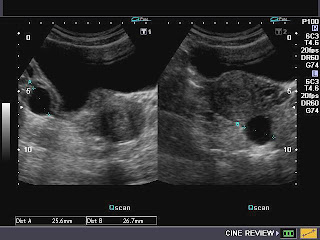With the increasing use of the ultrasound scan for screening purpose, more cases of ovarian cyst have been diagnosed than ever. Should you be worried if you have one, or two?
In more than 95% of time, ovarian cysts, which are just sacs filled with fluid, are harmless or not cancerous. It usually produces no symptoms, but may cause pain at the lower abdomen if the cyst burst, bleed or twist.

Normal ovaries are filled with many small cysts (usually <2.5cm – physiological cysts). During menstrual cycle, when an egg gradually mature in a cyst, the cyst will increase in size to become a follicle. When the egg is released, the follicle will turn into corpus luteum, which will then shrink in size gradually. However, sometimes this whole process does not occur in a perfect way. When the egg fail to get out from the follicle, follicular cyst will form. The size of follicular cyst is >2.5cm and sometimes can even reach 20cm. In other scenario, when the egg is released but the corpus luteum fail to shrink, a corpus luteum cyst will form. These 2 types of ovarian cysts are called functional cysts as they are part of the normal process of menstruation. They are generally harmless and will shrink in size after a few menstrual cycles.
Other non-functional but benign ovarian cysts include dermoid cyst, endometrioid cyst and cystadenoma. Dermoid cyst, or cystic teratoma is a benign tumour which contains various types of body tissues inside such as hair, bone, skin etc. This may sound scary but it is not cancer. Endometrioid cyst forms when menses blood flow backwards to the ovaries and collect there. It is also called a “chocolate cyst” because the cyst is filled with chocolate-like blood. Cystadenoma does not form from an ovarian follicles but from other part of the ovary. It is also benign though can be very large.
Dermoid cyst with hair inside
Chocolate cyst
To make it less complicated, ovarian cyst can be divided as follows:
Benign (>95%)
Functional (follicular cyst, corpus luteum cyst)
Non-functional (dermoid cyst, endometrioid cyst, cystadenoma, PCOS)
Malignant (cancerous)
From ultrasound, we can know the "growth" in the ovary is either cyst or solid. Solid growth is not good news. If it is a cyst, it can be a simple or a complex cyst. Simple cyst means that the cyst appears all black in an ultrasound image. It will be a complex cyst if there are white lines/dots inside. Simple cyst, like what it sounds, is usually functional cyst and harmless. Complex cyst can be either cancer or non-cancer and require closer monitoring or further test. Dermoid & chocolate cysts usually appear as complex cysts.
Simple ovarian cyst: usually harmless irrespective of size
Any ovarian cyst <2.5cm is normal (physiological). Cysts between 2.5-5cm are most likely functional cysts. Just repeat the ultrasound scan in 3 months time to see how it changes. Functional cysts will usually shrink in size or disappear in less than 3 menstrual cycles. However, if the size increases to >5cm, it may be non-functional cysts, which are still benign but need follow up scan. For ovarian cysts >10cm, intervention or surgery may be considered. Sometimes CT scan may be needed to further evaluate a complex cyst. The presence of endometrioid cyst even of any sizes may be harder to manage as it is usually associated with severe menses pain and infertility.
Ovarian cyst can occur in all ages. It is common in child-bearing age as the ovaries are forming follicles and corpus luteum in every menstrual cycle. However, if it is found in post-menopausal women, more attention need to be given as the risk of cancer increases since there will be no more functional cyst there.
Nevertheless, benign cysts can get bleeding, ruptured, twisted or infected. If you are worry or unsure, please consult a gynaecologist.







